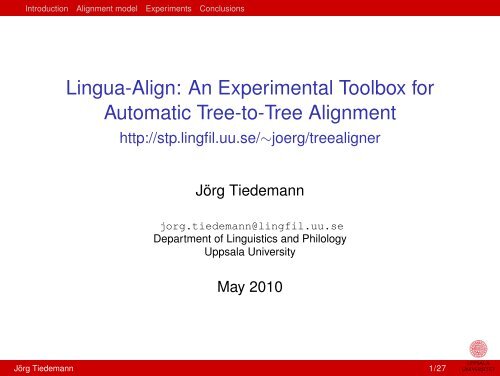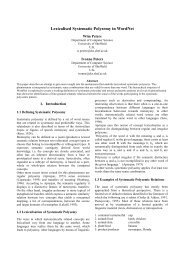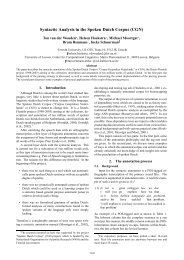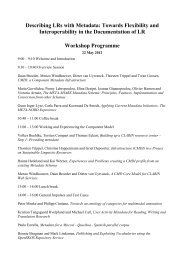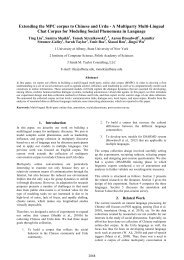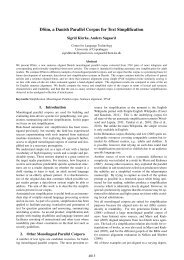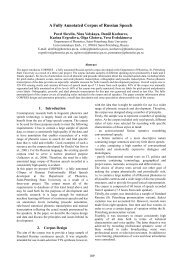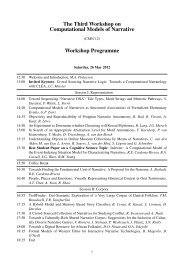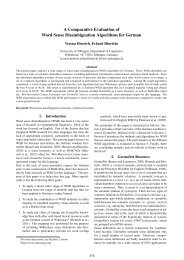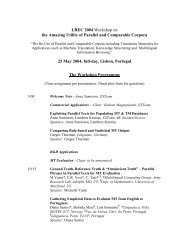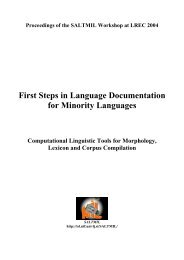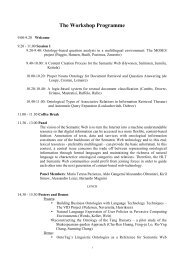Lingua-Align: An Experimental Toolbox for Automatic Tree-to-Tree ...
Lingua-Align: An Experimental Toolbox for Automatic Tree-to-Tree ...
Lingua-Align: An Experimental Toolbox for Automatic Tree-to-Tree ...
Create successful ePaper yourself
Turn your PDF publications into a flip-book with our unique Google optimized e-Paper software.
Introduction <strong>Align</strong>ment model Experiments Conclusions<br />
<strong>Lingua</strong>-<strong>Align</strong>: <strong>An</strong> <strong>Experimental</strong> <strong>Toolbox</strong> <strong>for</strong><br />
<strong>Au<strong>to</strong>matic</strong> <strong>Tree</strong>-<strong>to</strong>-<strong>Tree</strong> <strong>Align</strong>ment<br />
http://stp.lingfil.uu.se/∼joerg/treealigner<br />
Jörg Tiedemann<br />
jorg.tiedemann@lingfil.uu.se<br />
Department of Linguistics and Philology<br />
Uppsala University<br />
May 2010<br />
Jörg Tiedemann 1/27
Introduction <strong>Align</strong>ment model Experiments Conclusions<br />
Motivation<br />
<strong>Align</strong>ing syntactic trees <strong>to</strong> create parallel treebanks<br />
◮ phrase & rule extraction <strong>for</strong> (statistical) MT<br />
◮ data <strong>for</strong> CAT, CALL applications<br />
◮ corpus-based contrastive/translation studies<br />
Framework:<br />
◮ tree-<strong>to</strong>-tree alignment (au<strong>to</strong>matically parsed corpora)<br />
◮ classifier-based approach + alignment inference<br />
◮ supervised learning using a rich feature set<br />
→ <strong>Lingua</strong>::<strong>Align</strong> – feature extraction, alignment & evaluation<br />
Jörg Tiedemann 2/27
Introduction <strong>Align</strong>ment model Experiments Conclusions<br />
Example Training Data (SMULTRON)<br />
DT1<br />
The<br />
NP0<br />
NNP2<br />
garden<br />
IN4<br />
of<br />
PP3<br />
NP5<br />
NNP6<br />
Eden<br />
1. predict individual links (local classifier)<br />
NP1<br />
PM2<br />
Edens<br />
2. align entire trees (global alignment inference)<br />
NP0<br />
NN3<br />
lustg˚ard<br />
Jörg Tiedemann 3/27
Introduction <strong>Align</strong>ment model Experiments Conclusions<br />
Step 1: Link Prediction<br />
◮ binary classifier<br />
◮ log-linear model (MaxEnt)<br />
◮ weighted feature functions fk<br />
P(aij|si, tj) =<br />
1<br />
Z (si, tj) exp<br />
� �<br />
�<br />
λkfk(si, tj, aij)<br />
k<br />
→ learning task: find optimal feature weights λk<br />
Jörg Tiedemann 4/27
Introduction <strong>Align</strong>ment model Experiments Conclusions<br />
<strong>Align</strong>ment Features<br />
Feature engineering is important!<br />
◮ real-valued & binary feature functions<br />
◮ many possible features and feature combinations<br />
◮ language-independent & language specific features<br />
◮ directly from annotated corpora vs. features using<br />
additional resources<br />
Jörg Tiedemann 5/27
Introduction <strong>Align</strong>ment model Experiments Conclusions<br />
<strong>Align</strong>ment Features: Lexical Equivalence<br />
Link score γ based on probabilistic bilingual lexicons<br />
(P(sl|tm) and P(tm|sl) created by GIZA++):<br />
(Zhechev & Way, 2008)<br />
γ(s, t) = α(s|t)α(t|s)α(s|t)α(t|s)<br />
Idea: Good links imply strong relations between <strong>to</strong>kens within<br />
subtrees <strong>to</strong> be aligned (inside: 〈s; t〉)<br />
& also strong relations between <strong>to</strong>kens outside of the subtrees<br />
<strong>to</strong> be aligned (outside: 〈s; t〉)<br />
Jörg Tiedemann 6/27
Introduction <strong>Align</strong>ment model Experiments Conclusions<br />
<strong>Align</strong>ment Features: Word <strong>Align</strong>ment<br />
Based on (au<strong>to</strong>matic) word alignment: How consistent is the<br />
proposed link with the underlying word alignments?<br />
align(s, t) =<br />
�<br />
Lxy consistent(Lxy, s, t)<br />
�<br />
Lxy relevant(Lxy, s, t)<br />
◮ consistent(Lxy, s, t): number of consistent word links<br />
◮ relevant(Lxy, s, t): number of links involving <strong>to</strong>kens<br />
dominated by current nodes (relevant links)<br />
→ proportion of consistent links!<br />
Jörg Tiedemann 7/27
Introduction <strong>Align</strong>ment model Experiments Conclusions<br />
<strong>Align</strong>ment Features: Other Base Features<br />
◮ tree-level similarity (vertical position)<br />
◮ tree-span similarity (horizontal position)<br />
◮ nr-of-leaf-ratio (sub-tree size)<br />
◮ POS/category label pairs (binary features)<br />
Jörg Tiedemann 8/27
Introduction <strong>Align</strong>ment model Experiments Conclusions<br />
Contextual Features<br />
<strong>Tree</strong> alignment is structured prediction!<br />
◮ local binary classifier: predictions in isolation<br />
◮ implicit dependencies: include features from the context<br />
◮ features of parent nodes, child nodes, sister nodes,<br />
grandparents ...<br />
→ Lots of contextual features possible!<br />
→ Can also create complex features!<br />
Jörg Tiedemann 9/27
Introduction <strong>Align</strong>ment model Experiments Conclusions<br />
Example Features<br />
Some possible features <strong>for</strong> node pair 〈DT1, NN3〉<br />
feature value<br />
labels=DT-NN 1<br />
tree-span-similarity 0<br />
tree-level-similarity 1<br />
sister_labels=PP-NP 1<br />
sister_labels=NNP-NP 1<br />
parent_αinside(t|s) 0.00001077<br />
srcparent_GIZAsrc2trg 0.75<br />
DT1<br />
The<br />
NP0<br />
NNP2<br />
garden<br />
IN4<br />
of<br />
PP3<br />
NP5<br />
NNP6<br />
Eden<br />
NP1<br />
PM2<br />
Edens<br />
Jörg Tiedemann 10/27<br />
NP0<br />
NN3<br />
lustg˚ard
Introduction <strong>Align</strong>ment model Experiments Conclusions<br />
Structured Prediction with His<strong>to</strong>ry Features<br />
◮ likelihood of a link depends on other link decisions<br />
◮ <strong>for</strong> example: if parent nodes are linked, their children are<br />
also more likely <strong>to</strong> be linked (or not?)<br />
→ Link dependencies via his<strong>to</strong>ry features:<br />
Children-link-feature: proportion of linked child-nodes<br />
Subtree-link-feature: proportion of linked subtree-nodes<br />
Neighbor-link-feature: binary link flag <strong>for</strong> left neighbors<br />
→ Bot<strong>to</strong>m-up, left-<strong>to</strong>-right classification!<br />
Jörg Tiedemann 11/27
Introduction <strong>Align</strong>ment model Experiments Conclusions<br />
Step 2: <strong>Align</strong>ment Inference<br />
◮ use classification likelihoods as local link scores<br />
◮ apply search procedure <strong>to</strong> align (all) nodes of both trees<br />
→ global optimization as assignment problem<br />
→ greedy alignment strategies<br />
→ constrained link search<br />
◮ many strategies/heuristics/combinations possible<br />
◮ this step is optional (could just use classifier decisions)<br />
Jörg Tiedemann 12/27
Introduction <strong>Align</strong>ment model Experiments Conclusions<br />
Maximum weight matching<br />
Apply graph-theoretic algorithms <strong>for</strong> “node assignment”<br />
◮ aligned trees as weighted bipartite graphs<br />
◮ assignment problem: matching with maximum weight<br />
⎛⎡<br />
⎤⎞<br />
p11 p12 · · · p1n<br />
⎜⎢p21<br />
p22 ⎜⎢<br />
· · · p2n⎥⎟<br />
⎥⎟<br />
Kuhn − Munkres ⎜⎢<br />
.<br />
⎝⎣<br />
.<br />
.<br />
.<br />
. .<br />
.<br />
..<br />
. ⎥⎟<br />
. ⎦⎠<br />
=<br />
⎛<br />
⎜<br />
⎝<br />
pn1 pn2 · · · pnn<br />
→ optimal one-<strong>to</strong>-one node alignment<br />
Jörg Tiedemann 13/27<br />
a1<br />
a2<br />
.<br />
an<br />
⎞<br />
⎟<br />
⎠
Introduction <strong>Align</strong>ment model Experiments Conclusions<br />
Greedy Link Search<br />
◮ greedy best-first strategy<br />
◮ allow only one link per node<br />
◮ = competitive linking strategy<br />
Additional constraints: well-<strong>for</strong>medness (Zhechev & Way)<br />
(no inconsistent links)<br />
→ simple, fast, often optimal<br />
→ easy <strong>to</strong> integrate important constraints<br />
Jörg Tiedemann 14/27
Introduction <strong>Align</strong>ment model Experiments Conclusions<br />
Some experiments<br />
The <strong>Tree</strong><strong>Align</strong>er requires training data!<br />
◮ aligned parallel treebank: SMULTRON<br />
(http://www.ling.su.se/dali/research/smultron/index.htm)<br />
◮ manual alignment<br />
◮ Swedish-English (Swedish-German)<br />
◮ 2 chapters of Sophie’s World (+ economical texts)<br />
◮ 6,671 “good” links, 1,141 “fuzzy” links in about 500<br />
sentence pairs<br />
Train on 100 sentences from Sophie’s World (Swedish-English)<br />
(Test on remaining sentence pairs)<br />
Jörg Tiedemann 15/27
Introduction <strong>Align</strong>ment model Experiments Conclusions<br />
Evaluation<br />
Precision =<br />
F =<br />
|P ∩ A|<br />
|A|<br />
S = sure (“good”) links<br />
P = possible (“fuzzy” + “good”) links<br />
A = links proposed by the system<br />
Recall =<br />
2 ∗ Precision ∗ Recall<br />
Precision + Recall<br />
|S ∩ A|<br />
|S|<br />
Jörg Tiedemann 16/27
Introduction <strong>Align</strong>ment model Experiments Conclusions<br />
Results on different feature sets (F-scores)<br />
inference → threshold=0.5 graph-assign greedy +well<strong>for</strong>med<br />
his<strong>to</strong>ry → no yes<br />
lexical 38.52 40.00<br />
+ tree 50.27 51.84<br />
+ alignment 60.41 60.63<br />
+ labels 72.44 72.24<br />
+ context 74.68 74.90<br />
→ additional features always help<br />
Jörg Tiedemann 17/27
Introduction <strong>Align</strong>ment model Experiments Conclusions<br />
Results on different feature sets (F-scores)<br />
inference → threshold=0.5 graph-assign greedy +well<strong>for</strong>med<br />
his<strong>to</strong>ry → no yes no yes<br />
lexical 38.52 40.00 49.75 56.60<br />
+ tree 50.27 51.84 54.41 57.01<br />
+ alignment 60.41 60.63 61.31 60.83<br />
+ labels 72.44 72.24 72.72 73.05<br />
+ context 74.68 74.90 74.96 75.38<br />
→ additional features always help<br />
→ alignment inference is important (with weak features)<br />
Jörg Tiedemann 17/27
Introduction <strong>Align</strong>ment model Experiments Conclusions<br />
Results on different feature sets (F-scores)<br />
inference → threshold=0.5 graph-assign greedy +well<strong>for</strong>med<br />
his<strong>to</strong>ry → no yes no yes no yes<br />
lexical 38.52 40.00 49.75 56.60 50.05 56.76<br />
+ tree 50.27 51.84 54.41 57.01 54.55 57.81<br />
+ alignment 60.41 60.63 61.31 60.83 60.92 60.87<br />
+ labels 72.44 72.24 72.72 73.05 72.94 73.14<br />
+ context 74.68 74.90 74.96 75.38 75.03 75.60<br />
→ additional features always help<br />
→ alignment inference is important (with weak features)<br />
→ greedy search is (at least) as good as graph-based assignment<br />
Jörg Tiedemann 17/27
Introduction <strong>Align</strong>ment model Experiments Conclusions<br />
Results on different feature sets (F-scores)<br />
inference → threshold=0.5 graph-assign greedy +well<strong>for</strong>med<br />
his<strong>to</strong>ry → no yes no yes no yes no yes<br />
lexical 38.52 40.00 49.75 56.60 50.05 56.76 52.03 57.11<br />
+ tree 50.27 51.84 54.41 57.01 54.55 57.81 57.54 58.68<br />
+ alignment 60.41 60.63 61.31 60.83 60.92 60.87 62.09 62.88<br />
+ labels 72.44 72.24 72.72 73.05 72.94 73.14 75.72 75.79<br />
+ context 74.68 74.90 74.96 75.38 75.03 75.60 77.29 77.66<br />
→ additional features always help<br />
→ alignment inference is important (with weak features)<br />
→ greedy search is (at least) as good as graph-based assignment<br />
→ the well<strong>for</strong>medness constraint is important<br />
Jörg Tiedemann 17/27
Introduction <strong>Align</strong>ment model Experiments Conclusions<br />
Results: cross-domain<br />
What about overfitting?<br />
Check if feature weights are stable across textual domains!<br />
(Economy Texts in SMULTRON)<br />
setting Precision Recall F<br />
train&test=novel 77.95 76.53 77.23<br />
train&test=economy 81.48 73.73 77.41<br />
train=novel, test=economy 77.32 73.66 75.45<br />
train=economy, test=novel 78.91 73.55 76.13<br />
No big drop in per<strong>for</strong>mance! → Good!<br />
Jörg Tiedemann 18/27
Introduction <strong>Align</strong>ment model Experiments Conclusions<br />
Conclusions<br />
◮ flexible classifier-based tree alignment framework<br />
◮ rich feature set (+ context, + his<strong>to</strong>ry)<br />
◮ good results even with tiny amounts of training data<br />
◮ relatively stable across textual domains<br />
Jörg Tiedemann 19/27
Introduction <strong>Align</strong>ment model Experiments Conclusions<br />
The End<br />
Thanks!<br />
Questions? Comments? Discussion?<br />
http://stp.lingfil.uu.se/∼joerg/treealigner<br />
Jörg Tiedemann 20/27
Introduction <strong>Align</strong>ment model Experiments Conclusions<br />
Compatible with S<strong>to</strong>ckholm <strong>Tree</strong> <strong>Align</strong>er<br />
Jörg Tiedemann 21/27
Introduction <strong>Align</strong>ment model Experiments Conclusions<br />
<strong>Align</strong>ment Features: Lexical Equivalence<br />
Our implementation of α<br />
γ(s, t) = α(s|t)α(t|s)α(s|t)α(t|s)<br />
αinside(s|t) = �<br />
si ∈yield(s)<br />
αoutside(s|t) = �<br />
si /∈yield(s)<br />
max tj ∈yield(t)P(si|tj)<br />
max tj /∈yield(t)P(si|tj)<br />
GIZA++/Moses provide P(sl|tm) and P(tm|sl)<br />
Jörg Tiedemann 22/27
Introduction <strong>Align</strong>ment model Experiments Conclusions<br />
<strong>Align</strong>ment Features: Sub-tree Features<br />
Features that describe the relative position differences of nodes<br />
within the trees:<br />
tree-level similarity: 1 - difference in relative distance <strong>to</strong> root<br />
tree-span similarity: 1- difference in relative “horizontal” positions<br />
Size difference:<br />
leafratio: ratio of terminal nodes dominated by current tree nodes<br />
Jörg Tiedemann 23/27
Introduction <strong>Align</strong>ment model Experiments Conclusions<br />
Subtree features<br />
�<br />
d(si, sroot)<br />
tls(si, tj) = 1 − abs<br />
maxxd(sx, sroot) −<br />
�<br />
d(ti, troot)<br />
maxxd(tx, troot)<br />
�<br />
sstart + send<br />
tss(si, tj) = 1 − abs<br />
2 ∗ length(S) − tstart<br />
�<br />
+ tend<br />
2 ∗ length(T )<br />
leafratio(si, tj) = min(|leafnodes(si)|, |leafnodes(tj)|)<br />
max(|leafnodes(si)|, |leafnodes(tj)|)<br />
Jörg Tiedemann 24/27
Introduction <strong>Align</strong>ment model Experiments Conclusions<br />
Well-<strong>for</strong>medness Constraint<br />
“Descendants/ances<strong>to</strong>rs of a source linked node may only be<br />
linked <strong>to</strong> descendants/ances<strong>to</strong>rs of its target linked counterpart”<br />
→ no inconsistent links<br />
Jörg Tiedemann 25/27
Introduction <strong>Align</strong>ment model Experiments Conclusions<br />
Results: compare node types<br />
How good is the aligner on different node types?<br />
node type Recall Precision F<br />
non-terminals 78.08 82.32 80.15<br />
terminals 71.79 78.00 74.77<br />
Good on non-terminal nodes!<br />
1:1 alignment constraints probably <strong>to</strong>o strict <strong>for</strong> leaf nodes<br />
Jörg Tiedemann 26/27
Introduction <strong>Align</strong>ment model Experiments Conclusions<br />
Results: base features<br />
How good are base features on their own?<br />
features Prec Rec F<br />
lexical 66.07 36.77 47.24<br />
tree 30.46 34.50 32.36<br />
alignment 61.36 54.52 57.74<br />
label 36.14 35.12 35.62<br />
context-label 56.53 44.64 49.88<br />
Per<strong>for</strong>mance is low but promising!<br />
(Very little training data and very simple features!)<br />
Jörg Tiedemann 27/27


